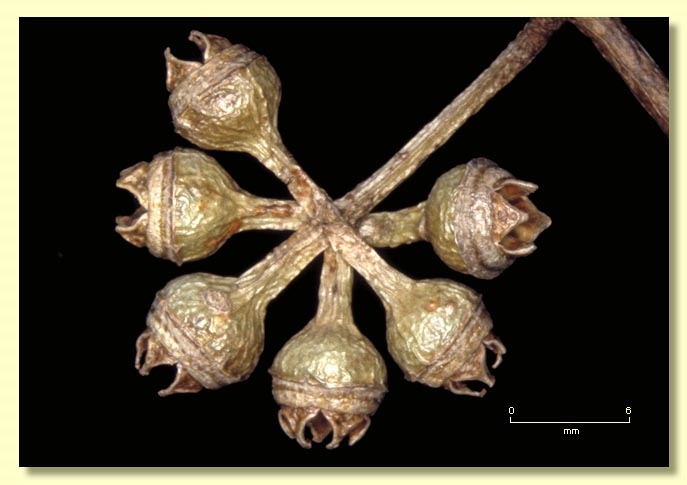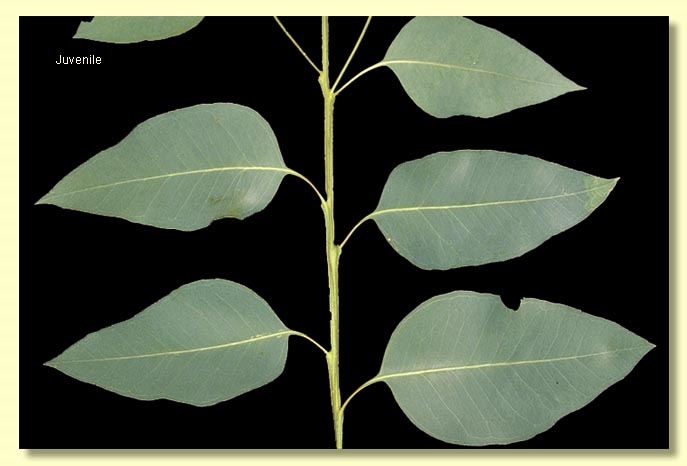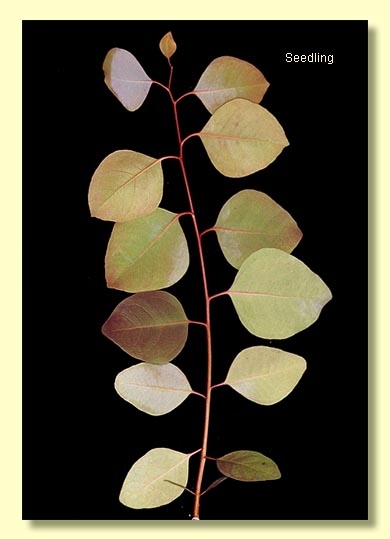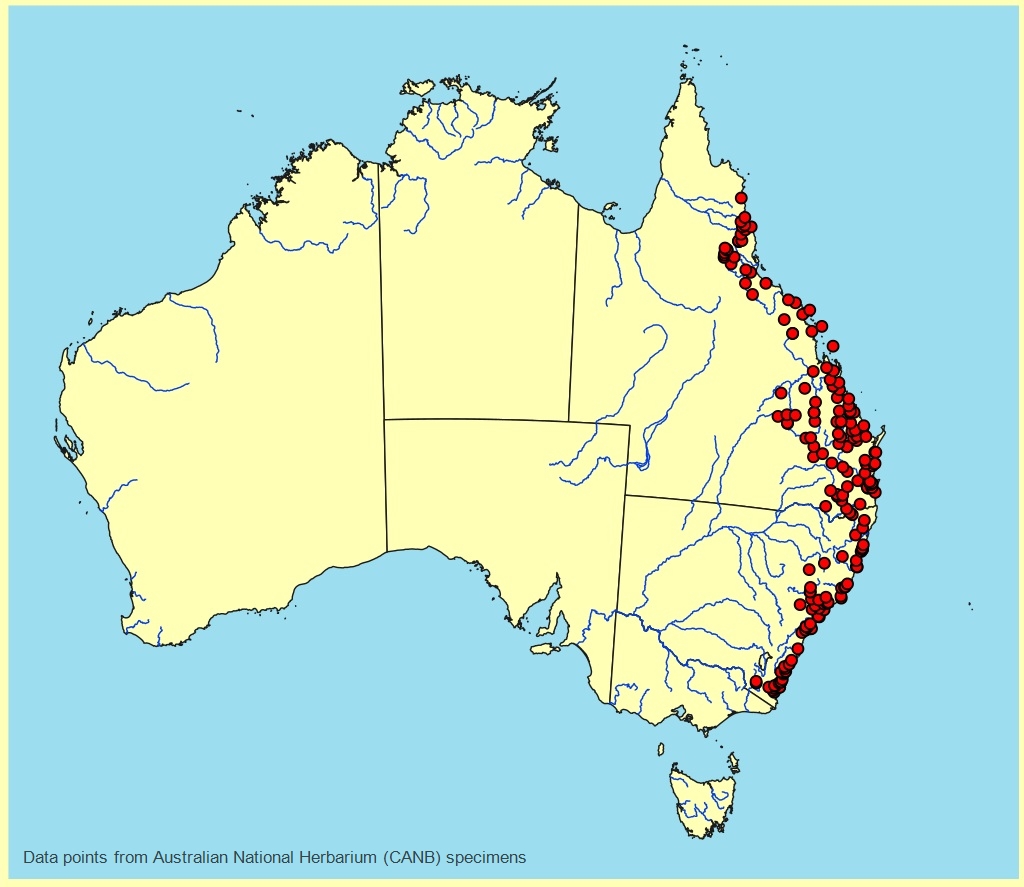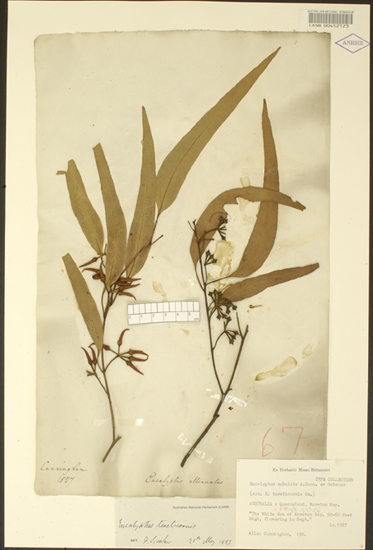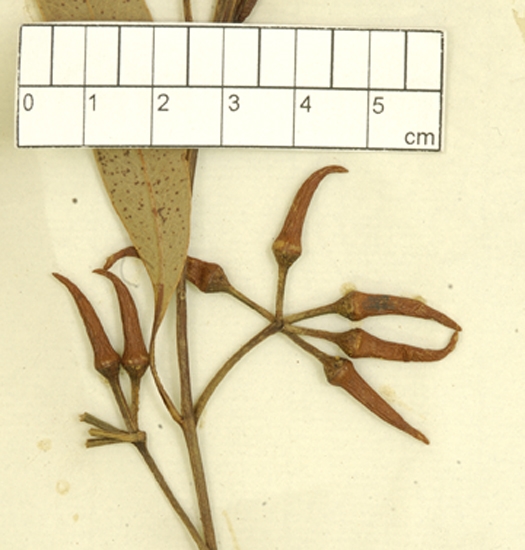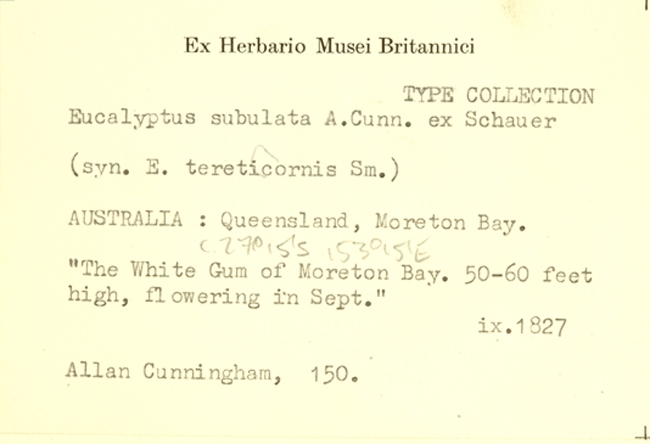Euclid - Online edition
Eucalyptus tereticornis subsp. tereticornis
Eucalyptus | Symphyomyrtus | Exsertaria | Erythroxylon
T: Port Jackson, NSW, 1793, J.White s.n.; holo: LINN; iso: BM.
Eucalyptus umbellata (Gaertn.) Domin, Biblioth. Bot. 89: 467 (1928) nom. illeg. non Desf. (1814); Leptospermum umbellatum Gaertn., Fruct. Sem. Pl. 1: 174 & t. xxxv (1788). T: Bay of Inlets, [Qld], 29 May 1770, J.Banks & D.Solander s.n.; holo: BM.
Eucalyptus populifolia Desf., Cat. Pl. Hort. Parisiensis 3rd edn, 284, 408 (1829). T: none cited.
Eucalyptus subulata A.Cunn. ex Schauer in W.G.Walpers, Repert. Bot. Syst. 2: 924 (1843). T: Moreton Bay, Qld, Sept. 1827, A.Cunningham 150; iso: BM, CANB, K, MEL.
Bark smooth throughout, mottled white, cream, yellow, pink and grey; sometimes with persistent dark grey flakes of rough bark on base of large trunks.
Juvenile growth (coppice or field seedlings to 50 cm): stem usually square in cross-section and prominently winged; juvenile leaves always petiolate, opposite for 5–8 nodes then alternate, ovate, 6–13 cm long, 3–8 cm wide, dull, blue-green or green.
Adult leaves alternate, petiole 1.3–3 cm long; blade lanceolate to falcate, 8–22 cm long, 1–3.5 cm wide, base tapering to petiole, concolorous, dull or glossy, green, side-veins greater than 45° to midrib, sparsely to moderately reticulate, intramarginal vein parallel to and just within margin or well removed from it (sometimes double), oil glands mostly island.
Inflorescence axillary unbranched, peduncles 0.7–2.5 cm long, buds 7, 9 or 11, pedicellate (pedicels 0.2–0.6 cm long). Mature buds elongated-ovoid dilated at or just above the join and then tapering (1–2.1 cm long, 0.3–0.6 cm wide), the hypanthium short, green to creamy, scar present (outer operculum shed early), operculum horn-shaped (0.8–1.8 cm long), stamens erect, anthers cuboid to oblong, versatile, dorsifixed, dehiscing by longitudinal slits (non-confluent), style long, stigma blunt, locules 4 or 5, the placentae each with 6 vertical ovule rows. Flowers white.
Fruit pedicellate (pedicels 0.2–0.5 cm long), hemispherical, 0.2–0.6 cm long, 0.4–0.8 cm wide, disc broad and steeply ascending, valves 4 or 5, strongly exserted.
Seeds usually black, 0.8–1.5 mm long, pyramidal or cuboid, dorsal surface usually pitted, ridges or angles minutely roughened (toothed), hilum terminal.
Cultivated seedlings (measured at ca node 10): cotyledons reniform to oblong; stems square in cross-section and sometimes winged; leaves always petiolate, opposite until nodes 5–7 then alternate, ovate, 5–12.5 cm long, 2.7–6.5 cm wide, base tapering, apex pointed, green to blue-green.
Flowering has been recorded in January, February, April, May, June, July, August, September, October and November.
E. tereticornis has been used for gums, timber, honey, ornamental and medicinal purposes.
Eucalyptus tereticornis is a species of forest tree widespread in eastern Australia and possibly southern New Guinea. It is characterised by its smooth bark, buds in clusters of 7 to 11 in the leaf axils, stamens held erect inside the buds, fruit with steeply raised disc and exserted valves, typically black, single-coated seed with roughened (toothed) margins; and dull broadly ovate juvenile leaves held in the vertical plane (not horizontal as in E. amplifolia ).
In the classification of Brooker (2000) Eucalyptus tereticornis belongs in the group of red gums (series Erythroxylon) which is distinguished by having buds with the stamens mostly erect, fruit where the disc is united to the ovary roof, valves conspicuously exserted and by the black, toothed, cuboid to pyramidal single-coated seed. There are 15 species belonging to this group: E. amplifolia, E. blakelyi, E. chloroclada, E. dealbata, E. dwyeri, E. flindersii, E. gillenii, E. glaucina, E. infera, E. kabiana, E. nandewarica, E. nudicaulis, E. tereticornis, E. terrica and E. vicina.
Eucalyptus tereticornis has been divided into 4 subspecies based on bud shape and juvenile growth.
E. tereticornis subsp. tereticornis
Has a horn-shaped operculum dilated at its base; operculum 4–7 times length of base (hypanthium).
A medium-sized to tall forest tree widespread in eastern Australia from Bega on the South Coast of New South Wales to Cape York Peninsula in north Queensland. Note that plants with buds matching this subspecies do occur in Gippsland, Victoria occasionally, but usually have seed either with two seedcoats like E. camaldulensis, or have pied seedcoats (black seedcoat overlaid with a partially developed yellow second seedcoat) suggesting plants of intermediate morphology.
E. tereticornis subsp. basaltica
Has ovoid buds with conical operculum not dilated basally and only 2–3 times the length of the hypanthium.
Occurs from south-east Queensland to the Sydney area of New South Wales frequently on basaltic substrates; trees with similar buds occur sporadically further south to Cobargo but are much less common than subsp. tereticornis. Seed always black and new juvenile growth green, never glaucous.
E. tereticornis subsp. mediana
Usually has much shorter, fatter buds than subsp. tereticornis with a broadly conical operculum that isn't basally dilated (operculum 2–4 times length of hypanthium).
Endemic to Gippsland in eastern Victoria, occurring from the Tambo River valley west to Sale and Licola. It grows near E. camaldulensis subsp. camaldulensis in part of its distribution, e.g. from Bairnsdale to Longford and Rosedale and it is possible that subsp. mediana originated from hybrids between E. tereticornis and E. camaldulensis. Seedlings of subsp. mediana have ovate leaves like typical subsp. tereticornis and show little variation while those of E. camaldulensis from the Sale area and elsewhere are typically lanceolate and vary little. The seeds of subsp. mediana can show characters of both E. tereticornis (black single-coated seed) and E. camaldulensis (yellow double-coated seed) and sometimes seed with only a partially developed second seedcoat thus appearing pied. Juvenile growth of subsp. mediana is often glaucous but this is soon lost as leaves mature. The populations of subsp. mediana were once widespread on the Gippsland Plain but are now reduced to remnants, mostly in poor health with sparse crowns and few buds and fruit. The best stands are at Briagolong and Moormurng. Similar obese-budded plants occasionally occurring on the South Coast of New South Wales, e.g. at Meringo, Tathra and near Guerilla Bay, but have juvenile leaves similar to E. amplifolia and are possibly of intermediate morphology.
E. tereticornis subsp. rotunda
The buds have operculum not dilated basally, usually with rounded blunt tip and 2–3 times the length of the hypanthium.
Restricted to central Queensland from areas of the Carnarvon Range above 500 m altitude, and possibly the Expedition Range also. The juvenile growth of this subspecies is very different: stems square in cross-section and strongly winged also, leaves broadly ovate to orbicular, prominently petiolate, green, held in vertical plane. This subspecies may be worth species rank.
Within series Erythroxylon, trees of E. tereticornis are most readily confused with E. amplifolia and E. blakelyi. E. amplifolia has distinctive deltoid to orbicular glossy green juvenile leaves, held horizontally into the juvenile and sapling stage, whilst the juveniles of E. tereticornis (and E. blakelyi ) are broadly ovate and dull and are held in the vertical plane. Also, E. amplifolia is a smaller tree and its buds have an operculum lacking the often swollen base compared with typical E. tereticornis subsp. tereticornis. E. blakelyi has a horn-shaped operculum similar to that of E. tereticornis subsp. tereticornis, and the juvenile leaves of both these species are indistinguishable. E. blakelyi is a woodland tree with a more inland distribution than E. tereticornis although the two may be difficult to distinguish in far northern New South Wales in the Yetman area, where populations of both are thought to overlap – there is no easy solution.
Two other Queensland red gum species have buds similar to typical E. tereticornis: E. kabiana, from Mt Beerwah in the Glasshouse Mountains, differs in its mallee habit and narrower lanceolate juvenile leaves. E. infera from the Inglewood to Warwick area is also a mallee but has small glossy dark green adult leaves and rounded and emarginate glossy green juvenile leaves.
Of the remaining 10 species in series Erythroxylon, all have buds where the conical to rounded operculum is never greater than twice the length of the base of the bud (hypanthium) thus giving an ovoid or diamond-shaped appearance. Six species are woodland trees or mallees of drier tableland or inland areas of New South Wales and/or Queensland: E. dealbata, E. chloroclada, E. vicina, E. dwyeri, E. nandewarica and E. terrica. One species, E. glaucina, is restricted to the wetter Hunter Valley area of New South Wales. The last three species are each of restricted distribution in the rocky ranges of the arid zone: E. flindersii in north-eastern South Australia, E. gillenii in Central Australia, and E. nudicaulis in the Mount Isa area of Queensland.
Within its area of occurrence, E. tereticornis may be confused with other smooth-barked red gums from the series Liberivalvae, viz. E. bancroftii, E. interstans, E. prava, E. parramattensis and E. seeana. E. tereticornis can be distinguished by its fruit which have a steeply ascending disc that is fused to the ovary roof. Species in series Liberivalvae all have fruit with an annular disc that is visibly free from the ovary roof (i.e. there is a gap between the disc and the base of the valves in the dehisced fruit).
MORE ABOUT RED GUMS AND OTHER ASSOCIATED GROUPS





